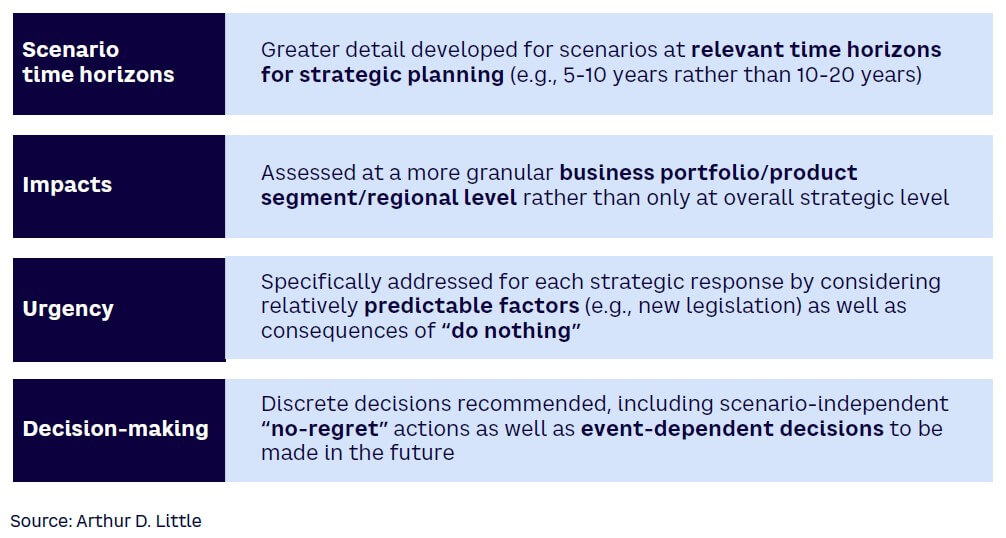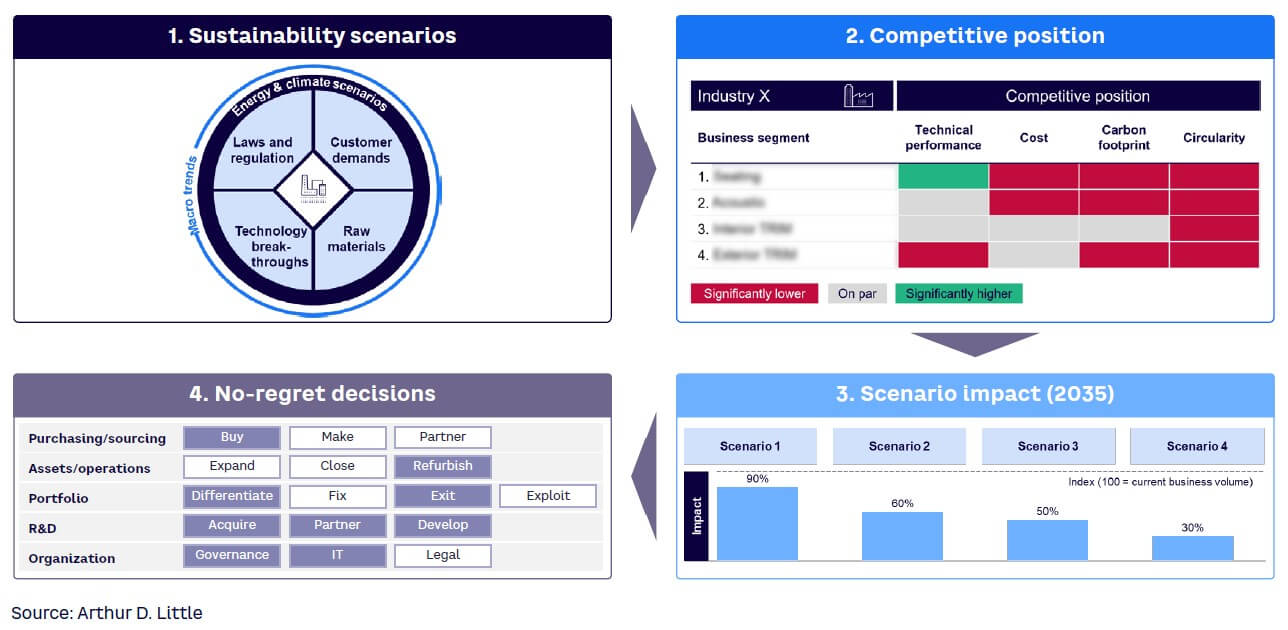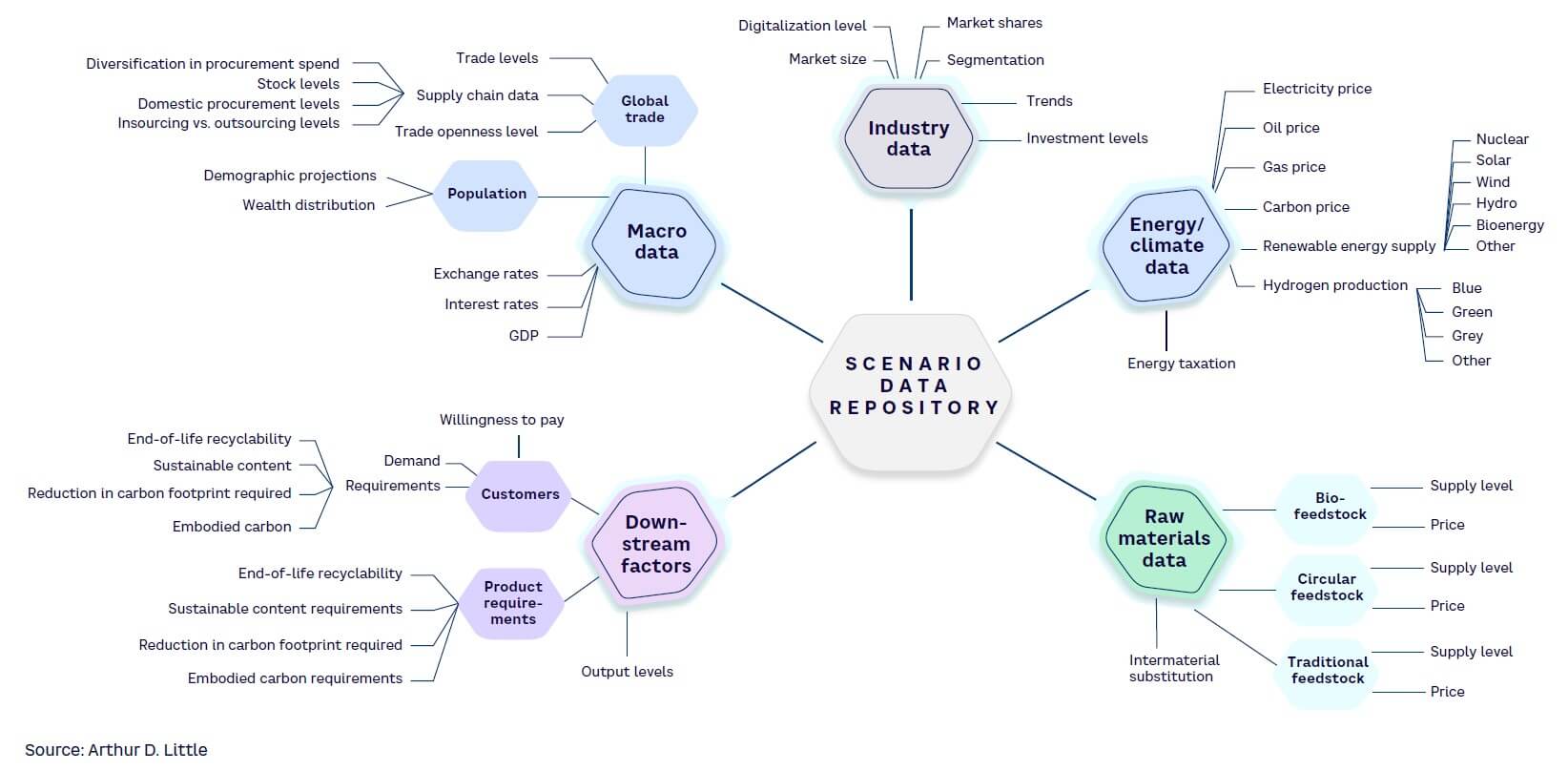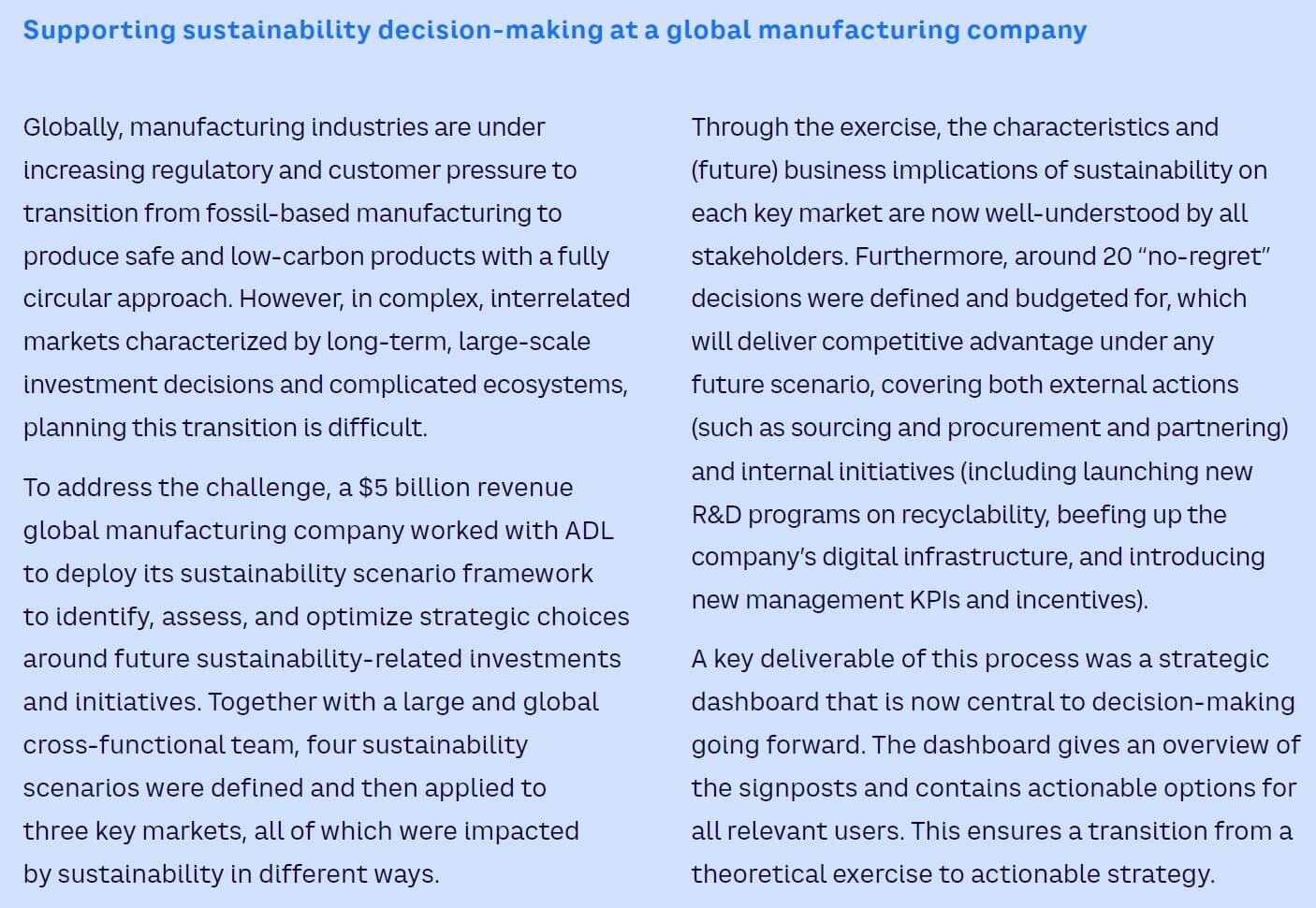
The need to transition to sustainable business models is a key topic for every senior manager. However, prioritizing sustainability is challenging due to its complexity, competing priorities, and uncertainty around legislation and technology progress. Despite the challenges, it’s crucial for companies to understand the necessary actions they have to take to meet long-term demands and targets. Adopting scenario-based planning is essential to gain this understanding.
OBSTACLES IN MAKING SUSTAINABILITY DECISIONS
Essentially, all organizations recognize that becoming more sustainable is vital to manage business risk in three areas:
-
Rapidly changing consumer and industrial demand.
-
New, greener entrants.
-
Legislation that requires business model transformation, such as the shift away from fossil fuel usage in power generation or circularity of materials.
This acknowledgement is why 80% of companies surveyed by Arthur D. Little (ADL) already have a sustainability strategy in place, with a further 12% developing one (see “Overcoming the Challenges to Sustainability”).
However, achieving sustainability is neither straightforward nor rapid. Especially in complex, asset-heavy manufacturing industries, future success in ensuring sustainability will require fundamental change to a combination of processes, product portfolios, and business operations, such as designing for recycling, adopting circular economy models, and safeguarding cost-effective supplies of green resources, such as biomaterials.
These changes require management boards to make major strategic decisions that impact their entire operations. Unfortunately, organizations struggle around when and how to make these decisions due to three primary factors:
-
A lack of certainty. Many areas around sustainability remain vague. How (and when) will demand change and will customers be willing to pay a green premium? Sustainability legislation varies between regions and countries, and in many cases has either not yet been implemented or its impact is uncertain. Green technology development has seen rapid strides, but it is unclear when it will mature sufficiently to become cost-effective. All of this adds up to doubts about the speed of change required from individual organizations. This translates into a lack of consensus within senior management about the direction to take, the investments to make, and the pace of transformation required.
-
A lack of C-level ownership. ADL research shows that most sustainability strategies are not core when it comes to investment decisions. As an example, just 8% of companies have changed their business models. Demonstrating this, most companies do not have a C-level chief sustainability officer with accountability for informed decision-making nor do they link financial remuneration incentives with sustainability targets. Given the complexity and difficulty of moving the needle internally on sustainability, this undermines effective action.
-
Long lead times. Corporate and legislative targets are long term (e.g., achieving net-zero carbon emissions by 2050), pushing them to the back of mind for executives, as they grapple with current, short-term challenges, like supply chain disruptions or energy crises. However, the changes required to decarbonize processes and supply chains have long lead times, as does the development of technologies to deliver sustainability. Decisions taken now will potentially deliver impacts decades later. This is outside common management time frames, which are normally measured in years, even in asset-heavy manufacturing industries.
All these factors mean that while businesses understand that sustainability decisions are important, they are not seen as urgent, leading to inertia and a lack of progress.
ADOPTING NEW APPROACH TO SCENARIO-BASED PLANNING
Scenario building is a well-established method of modeling possible futures, bringing together different layers of trends and factors to create plausible, coherent, and consistent narratives. Used for many decades, scenario planning enables organizations to monitor, plan, and shape their potential futures, providing actionable insights and time lines for the speed and depth of change. However, traditional scenario planning has its limitations, as it tends to focus on high-level strategic options, rather than actual decision-making. This means it often remains solely a research exercise. Or, if used, business planning typically picks the middle option for decision-making and budgeting and all too often ignores the other findings.
To overcome these challenges, ADL has developed and deployed an approach that builds on conventional scenario development, tailoring it to the specific requirements of sustainability decision-making. It adds sufficient granularity to understand the implications of sustainability drivers for decision-making at a business portfolio/regional level, including the question of timing and urgency. Figure 1 shows how the approach improves upon conventional scenario planning.

Creating effective sustainability scenarios
Building detailed, applicable sustainability scenarios means following a four-stage process, from initial research through to ongoing decision-making (see Figure 2).

1. Develop a range of credible scenarios
To be useful, scenarios must be individually meaningful and plausible, while collectively covering the range of possibilities within a realistic time frame that is neither too soon nor too far in the future (e.g., 2035). Data and facts should be central to the process — a rich repository of external and internal data points, as shown in Figure 3, will be the foundation of scenario building and eventual monitoring.
To ensure cohesion and consistency across scenarios, companies should begin with wider, proven macro trends, such as worldwide demographics or outlooks for the global economy.
Within those “macro constraints,” organizations can then position wider energy and climate scenarios, based on data from the International Energy Association (IEA) and Intergovernmental Panel on Climate Change (IPCC). These cover factors such as the use of renewables and stated government goals and targets around decarbonization.
Moving to a more granular level, the model then considers all sustainability factors and trends that impact specific industry scenarios across different end markets and regions. These could include regulation, customer demand, technology breakthroughs, and the availability and competition for more sustainable feedstock materials across industries and products. These factors should be based on credible projections within the time frame. They must be realistic rather than represent extremes if they are to drive decision-making. For example:
-
The costs of CO2 emissions could well rise above today’s levels, but the US Energy Information Administration (EIA) regards it as unlikely that by 2035 they will structurally exceed US $160-$170 per ton.
-
While economically viable breakthrough technologies may well emerge, their wider application will potentially still be constrained by economic limitations. An example case would be more circular raw materials emerging through breakthroughs, which may have widely varying availabilities depending on cross-sector competition dynamics.
The planning process generates multiple plausible scenarios, from a continuation of today’s situation to in-depth, fast, and global change driven by transformations in demand, regulation, technology, and cost-effective feedstock availability. However, unlike with traditional models, it is vital to understand that none of the scenarios simply represent “business as usual.” Even if sustainability trends stall over the coming years, the world will experience continued and worsening reminders of the importance of fighting climate change. This will create a world that is meaningfully different from today from a sustainability perspective. This reinforces the fact that “doing nothing” is a decision and may have significant consequences under all scenarios.
2. Apply the scenarios to your competitive position
After creating high-level scenarios, the next step is to apply them across the company and its portfolio of products/markets at a granular level. An organization achieves this by running a baseline competitiveness assessment to evaluate how products currently compare to competitors in key business segments based on three axes: cost, technical performance, and sustainability performance (e.g., carbon footprint and circularity performance). This step ensures that fact-based and commonly agreed product advantages are considered throughout the rest of the analysis.
3. Measure the impact of each scenario on key segments
Based on the company’s current competitive position, the impact of each sustainability scenario can be assessed and even quantitatively estimated on a product and/or market segment level. At this point, it is vital to understand specific drivers within markets and regions, as the importance of sustainability will vary among them. For example, a technically superior but fossil-based lightweighting solution in the automotive market may benefit from an accelerated adoption of electric vehicles (where weight is especially important). However, this advantage will apply only in regions where its higher carbon footprint is not excessively penalized by either regulators or consumers. Where such penalties are in force, biomass-based alternatives may become more viable. By deepening analysis to this level of granularity companies can consider the real impact of tightening sustainability concerns on margins and revenues in specific markets and regions.
4. Understand the no-regret decisions to take now, while planning for the future
Based on this full scenario analysis, senior management can make more deeply informed decisions, built upon the thorough analysis of current and future competitiveness. This ensures companies can break through strategic inertia by identifying “no-regret” decisions that will have positive outcomes irrespective of how future events unfold. These decisions could involve acquiring more sustainable raw materials, launching new R&D programs, or exiting certain market segments.
Importantly, the activity of completing such an analysis goes beyond addressing urgent actions to provide a timeline and triggers for future decisions. By providing a monitoring dashboard, the process delivers early warnings to trigger the implementation of further actions by businesses. For example, if the price of biomass reaches $X per ton, or legislation is passed in a particular region, then the organization can initiate an appropriate strategic response. The sidebar shares such an example from a global manufacturing company.
Building a model for informed decision-making
Despite the complexity and uncertainty around the speed and depth of change that achieving sustainability requires, it is vital that businesses make informed decisions regarding sustainability actions now. Otherwise, they will miss longer-term goals, fail to seize new opportunities, and most importantly, struggle to adapt to disruptions to their core business areas. They therefore need to understand impacts at a strategic and granular level and have the confidence to focus on no-regret, urgent decisions to drive future sustainability and competitiveness. Sustainability scenario planning gives the necessary, grounded, fact-based insight to enable informed decision-making both now and as markets, technologies, and regulations evolve.
Conclusion
TRANSFORMING STRATEGIC PLANNING AROUND SUSTAINABILITY
To successfully put sustainability scenarios at the heart of strategic planning, companies must adopt a robust, updated approach:
-
Begin by using credible macro and energy/climate data, and then internally agree on the most influential factors and their future projections. Then, combine these elements into a set of sustainability-focused scenarios.
-
Apply scenarios at a granular portfolio/regional level to analyze impacts on key business segments, based on specific product/portfolio competitive advantages.
-
Align all internal stakeholders by involving them in the process and gaining their buy-in.
-
Link conclusions to actions, starting with urgent “no-regret” decisions that will deliver benefits however markets and regulation develop.
-
Agree on practical signposts (e.g., raw material pricing or legislation) and automate monitoring of these through customized dashboards.






